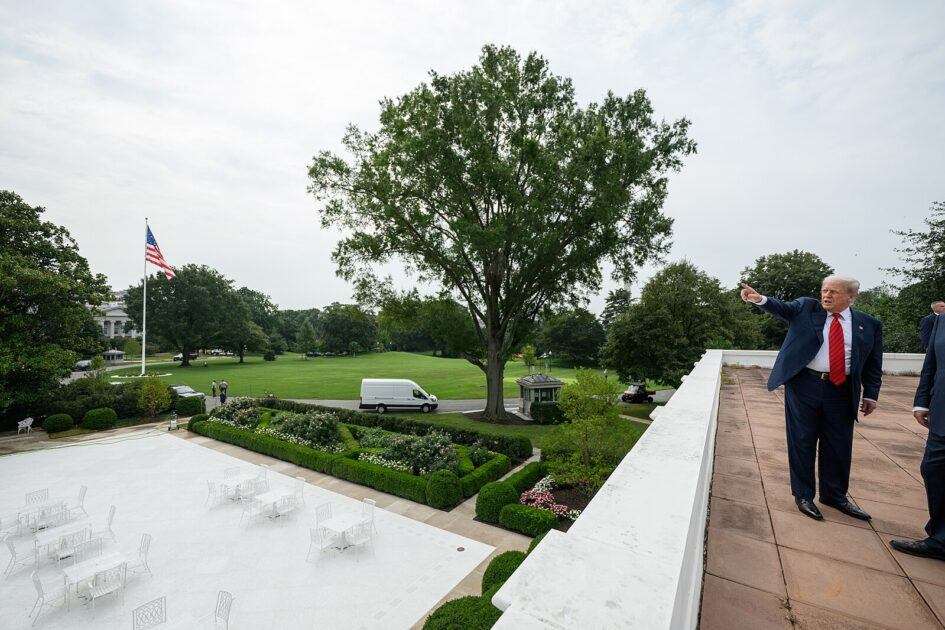


































































Photograph Source: The White House – Public Domain
Donald Trump’s destruction of the East Wing of the White House is more than just a serious renovation; it is a metaphor for his dismantling of traditional American governance and institutions. The East Wing, part of the 123-year-old symbol of American history – “the people’s house” – is being altered without the consent of the people, just as Trump has disregarded long-standing laws and traditions. Trump unilaterally decided that part of the White House had to go, just as he has decided that many American institutions have to go. Trump’s “renovation” is a declaration of contempt for the very architecture – literal and constitutional – of democracy. Framed as constructive destructive, his actions are destructive destruction.
The early twentieth-century economist Joseph Schumpeter emphasized the importance of creative destruction for the success of capitalism. “[T]he fundamental impulse that sets and keeps the capitalist engine in motion comes from the new consumers’ goods, the new methods of production or transportation, the new markets, [and] the new forms of industrial organisation that capitalist enterprise creates,” Schumpeter wrote. Charles Koch, Chairman and CEO of Koch Industries, summarized the modern version: “Embrace change. Envision what could be, challenge the status quo, and drive creative destruction.”
What happens if there is nothing “new” in creative destruction? What happens if destruction becomes an end in itself, when there is only destructive destruction?
There is no question that DJT is a destroyer. Consider the separation of powers. He has appointed intensely loyal followers to key legal positions, often ordering them to act contrary to legal precedent. Over forty prosecutors have been fired and flimsy charges have targeted political opponents, including the Attorney General of New York, Letitia James, and California Senator Adam Schiff. Trump is destroying the separation of powers and the objective rule of law.
His economic policies follow the same pattern. Tariffs on foreign goods have alienated traditional allies and undermined the multilateral trade system created at Bretton Woods after World War II with significant consequences for small and medium-sized American companies. Similarly, domestic initiatives like the so-called “Big Beautiful Bill” threaten health care for millions of Americans without a meaningful replacement or safety net. Attacks on the education system, the Department of Education and foreign aid further illustrate dismantling without replacement, leaving millions vulnerable domestically and internationally.
One could argue that there have been previous alterations to the White House so that that changes to the East Wing were not without precedent. Politically, one could also argue that America’s governance was also dramatically transformed by Franklin Roosevelt’s New Deal.
However, for a short answer, Adam Gopnik noted in The New Yorker, “The act of [the East Wing’s] destruction is precisely the point: a kind of performance piece meant to display Trump’s arbitrary power over the Presidency, including its physical seat.”
There is a very thin line between creative destruction and destructive destruction. How does one distinguish between creative destruction and destructive destruction?
Creative destruction is the dismantling of old structures or methods to make way for new systems, innovation or growth. Destructive destruction involves dismantling without meaningful replacement or improvement. It is often driven by ego or arbitrary power.
How can one judge what Trump is doing? The answers are process and long-term planning. In demolishing the East Wing, Trump did not consult the key institutions such as the National Capital Planning Commission, the Commission of Fine Arts, the National Trust for Historic Preservation, or the Society of Architectural Historians. When President Truman had the floors of the White House rebuilt, he created a commission with senators and congressmen to oversee the use of taxpayer’s money. Trump never went through the legal review process and taxpayers are in no way engaged.
Ben Rhodes summarized Trump’s behavior succinctly in the New York Times; “For Mr. Trump, the common thread weaving together so much of what he does — at home and abroad — is power. Whether he is seeking a cease-fire in Gaza or Ukraine, bombing boats off the coast of Venezuela or deploying troops to American cities, the desired result is his personal aggrandizement and the empowerment of his presidency.”
In addition to process, creative destruction involves foresight and long-term planning exemplified by the Allied powers during World War II. The Yalta, Potsdam, and Bretton Woods Conferences established what the political, economic and territorial situation would look like after the war. The Allies planned not only how to win, but also how to shape the future, including the United Nations.
In contrast, Benjamin Netanyahu’s destruction of Gaza, with American complicity, and the Trump Peace Plan are ad hoc, improvised processes with no planning for the future. Too many questions remain regarding Gaza’s governance and reconstruction. Where is the transition roadmap? Remember Trump’s boasting about making Gaza the “Riviera of the Middle East”? Now we question whether the reconstruction of Gaza will even begin before Hamas disarms. There is no equivalent to a Marshall Plan or a structured post-war transition. Israel’s policies, with American complicity, constitute destructive destruction.
The differences between creative and destructive destruction are not linguistic games. Trump’s frequently uses the language to “reinvent” government and policy and the rhetoric of creative destruction, In fact, his policies are too often disruptive destruction without constructive outcomes.
Creative destruction can be a force for creativity, innovation and improvement, Trump’s destructive destruction leaves nothing but ruin with no progress, no hope for renewal, only chaos masquerading as spectacle. Trump the destroyer leaves wreckage in his wake. No gold-gilded ballroom or Oval Office can change that reality.
The post Trump’s Destruction is Not Creative appeared first on CounterPunch.org.
This post was originally published on CounterPunch.org.